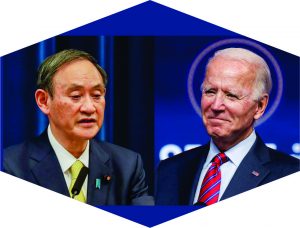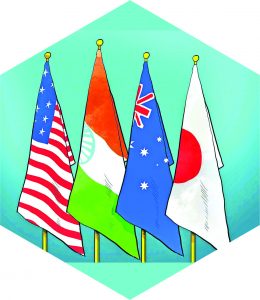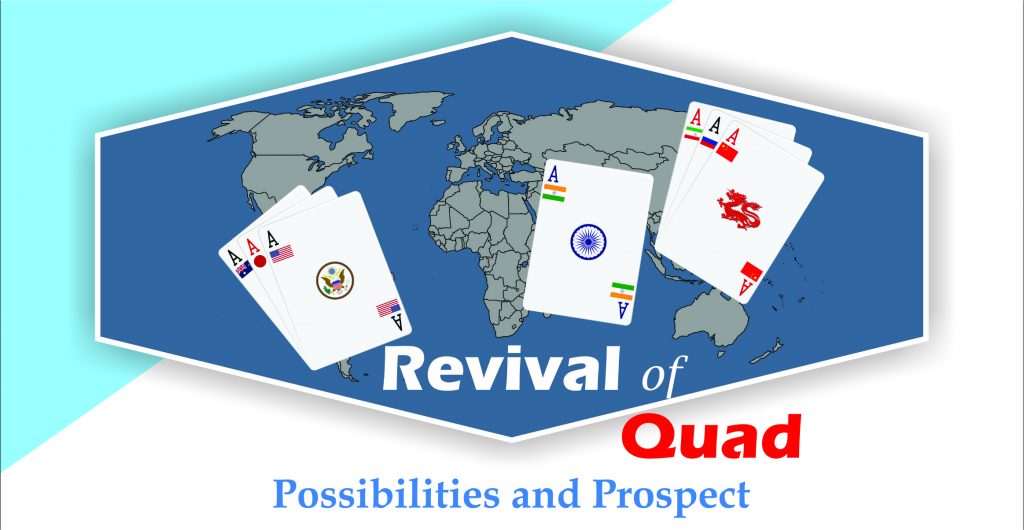Revival of Quad
Possibilities and Prospect
The Quadrilateral Security Dialogue, also referred to as Quad, is a strategic consultation framework between the United States, Australia, Japan and India. The Quad began nearly seventeen years ago (in 2004) with joint response to tangible and urgent crisis, the 2004 Indian Ocean earthquake and tsunami. For nine days in December 2004 and January 2005, the navies of the United States, Japan, Australia and India provided rapid and effective relief to injured and displaced people all around the Indian Ocean littoral.
 On sidelines of Association of Southeast Asian Nations (ASEAN) Regional Forum summit held in Philippines in August 2007, the four nations met to discuss options for further engagement. The idea was resurrected when Japanese Prime Minister Shinzo Abe, addressing the Indian Parliament on 22nd August 2007, brought about coupling of Pacific and Indian Oceans, called for an “arc of freedom and prosperity” and talked about ‘confluence of the two seas’. Quad enjoyed brief revival when the four countries, along with Singapore, held naval exercises in the Bay of Bengal in September 2007, which drew severe criticism from China. By 2008, Australia had expressed concerns about Quad and its impact on Sino-Australian relations and had withdrawn from further dialogue. Enthusiasm for Quad subsequently dissipated and idea largely disappeared from national diplomacy.
On sidelines of Association of Southeast Asian Nations (ASEAN) Regional Forum summit held in Philippines in August 2007, the four nations met to discuss options for further engagement. The idea was resurrected when Japanese Prime Minister Shinzo Abe, addressing the Indian Parliament on 22nd August 2007, brought about coupling of Pacific and Indian Oceans, called for an “arc of freedom and prosperity” and talked about ‘confluence of the two seas’. Quad enjoyed brief revival when the four countries, along with Singapore, held naval exercises in the Bay of Bengal in September 2007, which drew severe criticism from China. By 2008, Australia had expressed concerns about Quad and its impact on Sino-Australian relations and had withdrawn from further dialogue. Enthusiasm for Quad subsequently dissipated and idea largely disappeared from national diplomacy.
However, in a changed global and regional milieu, once again, Japan came forward and invited all members of the Quad in August 2017 to hold a joint meeting of foreign ministers during the ASEAN summit scheduled in November where American President-elect Donald Trump met Abe of Japan and agreed to pursue a ‘Free and Open Indo-Pacific’ strategy to especially counter the Chinese Belt and Road Initiative. Chinese anxiety was multiplied due to the US interest in the matter as the group met five times between 2017 and 2019. It followed their reforming meeting in New York City in 2019 and then in Bangkok and, on the instigation of US its members held first meeting of Quad Plus countries which include New Zealand, South Korea and Vietnam, and as a result a grand naval exercise was organised at Malabar in the year 2020, which followed the first-ever meeting on 12 March 2021 under the leadership of Joe Biden, the new President of the United States. However, keeping in mind the history of the alliance, it’s not an easy to be united against China as all of them have close bilateral relations with Beijing, despite all odds. In the context, all should keep in consideration that:
a. revival is only a signal but visibility is not objective but working together;
b. will have to maintain a balance between internal and external transparency;
c. in the set-up, function is more important than form;
d. each meeting should be result-oriented; and
e. also be conscious about the Chinese effort to divide the Quad as earlier.
Background of revival
 In fact, not formation of the Quad in 2007 but its revival in August 2017 on the initiation of Abe, then the Prime Minister of Japan, appeared more challenging for member countries viewing the developments of last one decade in the Indian Ocean and their relations with Beijing because today it has become more difficult to encircle China regionally as well as globally. At present, the Belt and Road Initiative (BRI) launched by China in the year 2013, has been recognised by most countries of the region and proliferated at world level, increasing the earlier status of the People’s Republic of China (PRC). On ideological fronts too, the liberal democratic order of the world is facing an unstoppable challenge from the state-run capitalism and the universal benchmark set by China. Beijing, in particular with Xi Jinping and earlier, have registered an unprecedented economic growth and lifted a large number of people from the below poverty line. Especially, the coming of Xi Jinping, his success in overall development of China and expanding its power and influence at global level and smartly using the geopolitical vacuum created by the relative decline of the West to reorder governance and the rule-based order have posed a challenge for the democratic system of the world at large. In last one decade, the authoritarian and hegemonic behaviour of China has prompted many leading scholars and thought leaders to demand urgent action from the United States of America and the European Union to check and, if possible, stop China’s soft and hard dealing at regional and global levels. In addition, the decade 2007-2017 also witnessed intense defence preparations on the part of China and the US in the Indian Ocean, and naval exercises on short intervals jointly by the Quad members on different places. These all gave a supportive hand for paving the revival of the Quad in 2017.
In fact, not formation of the Quad in 2007 but its revival in August 2017 on the initiation of Abe, then the Prime Minister of Japan, appeared more challenging for member countries viewing the developments of last one decade in the Indian Ocean and their relations with Beijing because today it has become more difficult to encircle China regionally as well as globally. At present, the Belt and Road Initiative (BRI) launched by China in the year 2013, has been recognised by most countries of the region and proliferated at world level, increasing the earlier status of the People’s Republic of China (PRC). On ideological fronts too, the liberal democratic order of the world is facing an unstoppable challenge from the state-run capitalism and the universal benchmark set by China. Beijing, in particular with Xi Jinping and earlier, have registered an unprecedented economic growth and lifted a large number of people from the below poverty line. Especially, the coming of Xi Jinping, his success in overall development of China and expanding its power and influence at global level and smartly using the geopolitical vacuum created by the relative decline of the West to reorder governance and the rule-based order have posed a challenge for the democratic system of the world at large. In last one decade, the authoritarian and hegemonic behaviour of China has prompted many leading scholars and thought leaders to demand urgent action from the United States of America and the European Union to check and, if possible, stop China’s soft and hard dealing at regional and global levels. In addition, the decade 2007-2017 also witnessed intense defence preparations on the part of China and the US in the Indian Ocean, and naval exercises on short intervals jointly by the Quad members on different places. These all gave a supportive hand for paving the revival of the Quad in 2017.
Forward movements
After a long gap, the historic virtual summit of Quad member countries held in New York on 12 March 2021 and a joint statement issued marked the significant milestone in the evolution of Quad which also gave a positive signal across the Indo-Pacific. In this context, sufficient background for the summit was prepared by elevating Quad talks to the ministerial level in 2019 when foreign ministers of all member countries met on the sidelines of UN General Assembly meeting in New York in the month of September, followed by their twice in-person meetings in Tokyo in October 2020 and in February 2021. A positive sign witnessed with the inauguration of Joe Biden as the new President of USA who from the first day expressed his willingness in containing China like his predecessor Donald Trump, and sought to promote the Quad as a key component in the Us’s Indo-Pacific strategy. He had special focus on group’s softer capabilities in place of singular counter-China orientation. As the summit was conducted in between the period of Covid-19 pandemic, they also decided to supply vaccines for the needy ASEAN countries. The spirit of the Quad summit as noted in the preamble ‘we strive for a region that is free, open, inclusive, healthy, anchored by democratic values and unconstrained by coercion. It also expressed concerns for economic and health impacts of Covid-19, climate change, and shared challenges in cyber space, critical technologies, counterterrorism and many such issues haunting the whole humanity in general. They also decided to establish new working groups on vaccines, emerging tech and climate and hold an in-person summit of member leaders by the end of 2021.
The real Chinese challenge
In 1990s, the United States of America was twenty times bigger than the People’s Republic of China and today the difference between the two is only 1.5 which shows the immense development China has made over the years. The country has proved itself in each and every sector, and, therefore, the old or traditional perception about the nation demand it to be changed with values, power and privileged attached at regional and global levels. Its economy is today of US$12 trillion, the second largest in the world and most integrated globally, likely to overtake the US in less than a decade. The present volume of China’s economy is even much bigger than the USSR’s which was also a giant in military power, and hence, any threat of economic or trade sanctions would certainly not work and may invite instability in world economy.
Aspirations of Quad
 Quad countries strive for a region that is free, open, inclusive, healthy, anchored by democratic values and unconstrained by coercion. Today’s global devastation wrought by Covid-19, threat of climate change and security challenges facing the region summon Quad countries with renewed purpose. Quad countries commit to promoting a free, open rules-based order, rooted in international law to advance security and prosperity and counter threats to both in Indo-Pacific and beyond. They support the rule of law, freedom of navigation and overflight, peaceful resolution of disputes, democratic values and territorial integrity. Quad countries have committed to work together and with a range of partners and reaffirmed their strong support for ASEAN’s unity and centrality. Quad seeks to uphold peace, prosperity and strengthen democratic resilience, based on universal values. Quad countries have pledged to respond to economic and health impacts of Covid-19, combat climate change and address shared challenges including those in cyber space, critical technologies, counterterrorism, quality infrastructure investment and humanitarian-assistance and disaster-relief, as well as maritime domains. Quad will collaborate to strengthen equitable vaccine access for Indo-Pacific, with close coordination with multilateral organisations, including World Health Organisation. Quad is united in recognising that climate change is global priority and will work to strengthen climate actions of all nations, including keeping a Paris-aligned temperature limit within reach. Quad will begin cooperation on critical technologies of future to ensure that innovation is consistent with free, open, inclusive and resilient Indo-Pacific. Quad will continue to prioritise role of international law in maritime domain, particularly as reflected in United Nations Convention on Law of the Sea, and facilitate collaboration, including in maritime security, to meet challenges to rules-based maritime order in East and South China seas.
Quad countries strive for a region that is free, open, inclusive, healthy, anchored by democratic values and unconstrained by coercion. Today’s global devastation wrought by Covid-19, threat of climate change and security challenges facing the region summon Quad countries with renewed purpose. Quad countries commit to promoting a free, open rules-based order, rooted in international law to advance security and prosperity and counter threats to both in Indo-Pacific and beyond. They support the rule of law, freedom of navigation and overflight, peaceful resolution of disputes, democratic values and territorial integrity. Quad countries have committed to work together and with a range of partners and reaffirmed their strong support for ASEAN’s unity and centrality. Quad seeks to uphold peace, prosperity and strengthen democratic resilience, based on universal values. Quad countries have pledged to respond to economic and health impacts of Covid-19, combat climate change and address shared challenges including those in cyber space, critical technologies, counterterrorism, quality infrastructure investment and humanitarian-assistance and disaster-relief, as well as maritime domains. Quad will collaborate to strengthen equitable vaccine access for Indo-Pacific, with close coordination with multilateral organisations, including World Health Organisation. Quad is united in recognising that climate change is global priority and will work to strengthen climate actions of all nations, including keeping a Paris-aligned temperature limit within reach. Quad will begin cooperation on critical technologies of future to ensure that innovation is consistent with free, open, inclusive and resilient Indo-Pacific. Quad will continue to prioritise role of international law in maritime domain, particularly as reflected in United Nations Convention on Law of the Sea, and facilitate collaboration, including in maritime security, to meet challenges to rules-based maritime order in East and South China seas.
Epilogue
From realist perspective, geopolitics is much about establishing spheres of influence; therefore, Indo-Pacific as a geopolitical construct will necessarily involve such competition. While the US seeks to maintain its influence in the region in face of Chinese challenge, it also seeks to boost India’s influence eastwards of Malacca Straits, and Japan’s influence in Indian Ocean. The underlying motivations, levels of engagement and views of Quad as a possible instrument to balance against strengthening Chinese role in Indo-Pacific region vary for each of the grouping’s members. In spite of converging interests among Quad members, unsteady normative foundations of the grouping are factors preventing serious revival of Quad. China’s strategic initiatives in South China Sea and Indian Ocean make it imperative to include more countries like Indonesia and Philippines into security architecture for the region. Quad needs to shift its focus from its novel form of dialogue toward joint functional action by the group on most pressing priorities that others in the region now face. If other countries in Asia view Quad as little more than talk shop to discuss looming risks posed by China’s rise while occasionally holding joint military exercises, it is unlikely that other countries will see its utility or view it as a model for their own choices and conduct. Quad countries must demonstrate in action that they are making major contributions to solving larger economic, transnational and environmental challenges that affect others in Indo-Pacific. If it does so successfully, Quad can comprise firm core of an elastic regional architecture. Priority should not be on countering China for its own sake but on increasing areas of alignment and cohesion with larger community of potential problem-solving partners. That is the best path for advancing interests of Quad countries, preserving security and promoting development in Indo-Pacific.
The writer is a member of staff.
 Jahangir's World Times First Comprehensive Magazine for students/teachers of competitive exams and general readers as well.
Jahangir's World Times First Comprehensive Magazine for students/teachers of competitive exams and general readers as well.



